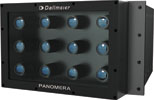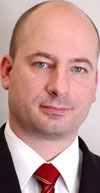

The Panomera multi-focal sensor system from Dallmeier is making a big splash. Yet the company that manufactures it is deliberately not calling it a camera but a multifocal sensor system. And even though it talks in terms of many megapixels, Dallmeier insists that the number of megapixels is fundamentally not the decisive element. Dr. Martin Theis, product manager at Dallmeier expands.

What is so innovative about the Panomera system?
Theis: With the Panomera multi-focal sensor system, a huge area can be surveyed from a single location extremely efficiently. The most impressive aspect of the product is that it combines the overall view with simultaneous top detail resolution: Even more distant objects are displayed with the same resolution as objects in the foreground of the picture.
In principle, it is exactly what the user wants from a video surveillance camera. The entire area observed by the camera should be displayed in uniformly high quality. But anyone who has ever zoomed in on an image will notice a marked difference: While objects in the foreground are certainly displayed with sufficient resolution, when the user attempts to enlarge objects from the background, they appear as so many ill-defined blocks.
Let us consider an example taken from real life. Look at the image of a large car park outside a shopping centre. The number plates of the cars in the front rows are still legible, but in the back rows the image loses definition when it is enlarged and it is no longer possible to make out the letters. This is why when we developed the Panomera; one of our objectives was to ensure that the resolution never fell below the specified parameters, not even in the most distant areas of the image.
How is this high resolution possible?
Theis: We are using a completely new lens and sensor concept. In conventional cameras, the pixels are used uniformly within the sensor, that is to say, the available megapixels are distributed evenly throughout the entire image. But the actual scene is not two-dimensional like the sensor, it is three-dimensional – and the expanse of the lateral and depth perspectives becomes progressively larger the farther back you go. Now if the pixels are distributed evenly on the camera sensor, this means that the same number of pixels is available for capturing a much larger area than in the foreground of the image. And logically, as a result more distant objects cannot be resolved any more when you zoom in.
With Panomera, we can guarantee uniform resolution over the entire object space. We do not use just a single optical device, but a multifocal sensor system, meaning several lenses with different focal lengths. In this way, we ‘slice up’ the scene so that each area has the optimum focal length assigned to it.
Could you not also achieve this effect by using several HD cameras in conjunction with each other?
Theis: In order to obtain comparable resolution, you would have to stretch material resources to the limit. And apart from that, as the user you would have to divide your attention among that many more single images. Multiple distributed HD cameras would certainly not enable you to work as efficiently and ergonomically as a single integrated system. In developing the Panomera, we invested a tremendous amount of expertise and years of experience in the field of video security technology in order to make this possible. You will not find a comparable system on the market today.
What is your position in the debate regarding the constant increase in numbers of megapixels?
Theis: In general, you can ignore the discussions about numbers of megapixels and the resulting rivalry among manufacturers to increase megapixel resolutions. We began developing the Panomera using an entirely different approach. What exactly does the customer want? In theory, the customer is not particularly concerned whether a camera has 12 or 21 megapixels.
The key question for the end user is how clearly and sharply the object he wants to see will be displayed. So we turned our thinking upside down. We did not want to increase the number of pixels on the sensor just so that we could stay abreast of the market in terms of megapixel numbers. The bottom line for us was the surveillance task the device was intended to perform: How do we create a system that is capable of showing more distant objects at the same high resolution and with good contrast?
Instead of the number of sensor pixels, we use the resolution in pixels per metre as the basis for our measurements. Strictly speaking, the correct terminology should even be line pairs per metre.
A line pair consists of one black bar and one white bar. If you move across a line pair transversely, the brightness switches from zero to one. This switch from bright to dark (modulation) loses contrast due to the optics, the sensor, the electronics, etc., until the two bars, which were originally quite distinct become grey-in-grey as the line density increases. Anyone who has handled cameras seriously is familiar with the bar charts on which you look for the point where two bars become indistinguishable.
This limit value, line pairs per metre, shows precisely how many black and white bars an observed object can be divided into. And this number in turn can be compared with the limit values for ‘observation’, ‘recognition’ and ‘identification’ that the military and police security experts work with. So the question is not how many pixels you have, but how the object appears in the image.
Dallmeier is still advertising high megapixel counts as a selling point.
Theis: Yes, that is true. The end customer is faced with an enormous variety of different HD and megapixel cameras, and of course, he wants to be able to compare them with each other. So we too provide megapixel and resolution comparisons with conventional cameras, so that prospective buyers have common points of reference and comparison. For example, if we can recognise individuals at a distance of 160 metres, which is quite possible with Panomera, with a conventional design we would have to be considering a 200 megapixel camera or even more in order to obtain the same resolution! Comparisons of this kind are helpful for the customer, although I would like to emphasise again that Panomera is not just a new super-megapixel camera, it is based on an entirely new technology.
Another advantage of the Panomera is that it continuously records the overall image. Is that not standard practice?
Theis: Unfortunately it is not. Of course, fixed dome or box cameras always record the whole of the area they are surveying. But these cameras are not equipped with an optical zoom, so they are not suitable for monitoring expansive areas, or at least only as overview cameras. This is why many PTZ cameras are being used at the moment. These can be used to zoom and move within the scenes. But at the same time PTZ cameras have a definite disadvantage: They can only ever record the area that the operator is currently watching live.
Let us revisit the example of our car park: If the operator is currently zooming in on the front left portion of the image, only this area is being recorded. So if an incident were to take place at a different location at the same time, it would not be possible to review it afterwards. With Panomera, on the other hand, the entire scene is recorded continuously and in maximum detail resolution – regardless of which area the operator is viewing live. This makes it possible to analyse incidents after they have occurred.
What plans do you have for Panomera in the future?
Theis: We are in the process of completing project studies for a large number of customer enquiries. Because Panomera is not a mass-produced ‘off-the-rack’ solution for all requirements. We perform the necessary project studies in advance to ensure that the multifocal sensor system is customised and the resolution required by the customer is achieved.
Our first projects have already been put into operation, because many customers have realised how cost-efficient the system is compared with conventional equipment. I am sure that we will be putting many more such projects into operation in the near future.
For more information contact Dallmeier Electronic, +49 941 8700 0, [email protected], www.dallmeier.com

© Technews Publishing (Pty) Ltd. | All Rights Reserved.